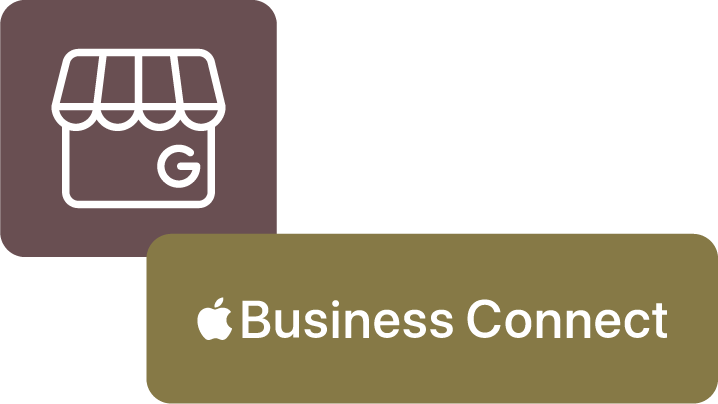Healthcare providers are mastering the art of healing, but when it comes to effectively marketing their services and attracting new patients, many seem to be struggling.
Now, this isn’t a backhanded compliment, but the objective truth: patients truly need their doctors’ undivided time and attention to be directed towards their healthcare. Limited time and expertise to dedicate to marketing as well as HIPAA regulations that restrict marketing possibilities make healthcare marketing a challenge. However, effective marketing is also an invaluable opportunity to grow and improve your healthcare organization.
Today, there are many modern healthcare marketing tools that can help you attract more new patients and foster patient attention in a cost-effective and time-efficient way.
Without further ado, here’s a (more-or-less) concise list of our favorite healthcare marketing tools that can help you grow your patient base and improve profitability.
 1. Google Business Profile (GBP) and Apple Business Connect (ABC) Listings
1. Google Business Profile (GBP) and Apple Business Connect (ABC) Listings
These listings are a must for all healthcare providers hoping to be found online. The nature of healthcare as a local service requires your marketing to heavily rely on local search and online reputation.
What Are Google Business Profiles and Apple Business Connect?
While there are many online listings you could benefit from, both general (such as Yelp) and healthcare-specific (such as Healthgrades), these two bring the most value due to their ownership belonging to two online giants: Google and Apple.
Google Business Profile (GBP)
Formerly Google My Business (GMB), Google Business Profile allows businesses to manage their online presence on Google, including search and maps.
The benefits of leveraging this platform are invaluable, as Google gets 70,000 health-related searches per minute every day (you read that right), while ‘near me’ searches for healthcare services have doubled since 2015.
Having a well-optimized GBP listing can be a valuable healthcare marketing tool that will position you in relevant search results both on Google’s search engine and on Google Maps. You simply can’t lose.
Apple Business Connect (ABC)
Like GBP, Apple Business Connect helps businesses manage their information across Apple Maps and other Apple services.
Since the number of iPhone users in the US hit 136 million in 2023, many potential patients will inevitably use Apple Maps for their healthcare-related queries. And you want to be there for them when they do.
What Are GBP & ABC Useful for in Healthcare Marketing?
These marketing tools offer several benefits that can enhance your healthcare practice’s online presence and patient engagement:
- Improve Local SEO: GBP and ABC help you improve your local search visibility, making it easier for potential patients to find your practice. Practices with complete and accurate listings are more likely to appear when potential patients search for relevant healthcare services in their area.
- Boost Your Online Reputation: GBP streamlines the collection and display of patient online reviews, boosting your healthcare practice’s online reputation. Positive reviews improve your ranking in search results and build trust with your audience. Regularly responding to reviews shows that you value patient feedback and are willing to improve the quality of care to meet their expectations.
- Provide Accurate and Reliable Contact Information: As patients use GBP and ABC listings to find and contact healthcare providers, these platforms make your NAP (Name, Address, Phone Number) information easily accessible. To maintain credibility, provide a good user experience, and avoid any mishaps that could cause patient frustration, you must regularly check and confirm this information within your listings.
How to Leverage GBP and ABC as Healthcare Marketing Tools?
- Complete Your Profile: Ensure all information, such as name, address, phone number, business hours, but also services, specialties, and a tightly-written owner’s description, is accurate and complete.
- Keep Adding Visuals: Upload high-quality images and videos of your premises, staff, and equipment, and, when possible, encourage your patients to add their own as part of their online review.
- Request and Manage Reviews: Encourage satisfied patients to leave positive reviews and respond to them to show that you value feedback, always protecting their PHI in the process.
- Post Updates: Use the posting feature to regularly provide updates about your practice, such as new services, health tips, or events. This is beneficial to users and search engines alike.
- Centralize Listing Management: To further benefit from this asset and enhance your practice’s credibility, consider automating review requests and centralizing review management.
Which Stage of The Patient Journey Are GBP & ABC Most Impactful in?
While these listings prove to be beneficial in each stage of the patient journey, they’re most useful during the Awareness and Decision Stage.
During the Awareness Stage, they help patients discover you online, while during the Decision Stage, these listings help make patients’ minds up by showcasing your reputation through other patients’ experiences and provide simple and easy ways for patients to access your practice.
 2. Predictive Targeting in Healthcare
2. Predictive Targeting in Healthcare
Predictive targeting uses data analytics to identify and target potential patients who are likely to need your services.
While predictive targeting is nothing new in other industries, it has been quite restricted in healthcare due to data privacy concerns and HIPAA regulations. However, contemporary healthcare marketing tools now enable providers to benefit from this highly lucrative digital marketing strategy.
Which Predictive Targeting Tool Is Best for Healthcare Marketing?
SocialClimb’s predictive targeting tool is the only existing healthcare marketing tool that allows for HIPAA-compliant patient targeting.
This healthcare marketing tool leverages machine learning and extensive data points to identify and reach prospective patients in need of specific healthcare services. By analyzing demographic information, technology usage, financial details, and online behaviors, it creates precise predictive models to target high-value patients effectively.
SocialClimb’s predictive targeting tool enhances marketing efficacy, reduces costs, and increases ROI by focusing on the most profitable services and patients. It integrates seamlessly into marketing strategies, allowing for targeted postcard marketing and digital ad campaigns while ensuring HIPAA compliance.
What Is It Useful for?
Simply put, this healthcare marketing tool helps you bring in new, high-value patients in a simple, reliable, and cost-effective way. Here’s how:
- Personalized Marketing: Predictive targeting allows you to create tailored marketing campaigns that resonate with specific patient segments.
- Increased Engagement: Targeting individuals who are in actual need of care and most likely to engage with your services improves campaign efficiency and performance.
- Attracting High-Value Patients: This healthcare marketing tool allows you to effectively target at-risk patients for high-value procedures that your practice aims to promote more actively.
- Accurate, HIPAA-compliant Conversion Tracking: Compliant PM/EHR integrations enable detailed conversion tracking while ensuring patient data remains protected.
- Scalable Growth: Healthcare providers who use predictive targeting have seen up to 2,500% return on their marketing investment.
How to Leverage Predictive Targeting as A Healthcare Marketing Tool?
Here’s our best advice on how to ensure you get the most out of the predictive targeting tool for your healthcare organization:
-
- Hit The Spot with Custom Campaigns: Develop targeted marketing messages and campaigns tailored to each audience segment’s needs. For example, when promoting knee surgery, create distinct campaigns: one for athletes emphasizing recovery speed and performance, and another for older adults focusing on improved mobility and quality of life.
- Social Media Advertising: Market on social media with highly targeted ads tailored to generated audiences, increasing engagement and conversion rates by delivering personalized content to the right audience.
- Postcard Marketing: Use trackable postcards to reach your intended audience, incorporating QR codes and call tracking to measure campaign performance effectively.
- Data Collection: Gather useful data on patient behavior in a HIPAA-compliant way to make data-informed marketing and patient interaction decisions.
- Analyze Success Patterns: Use analytical tools to identify trends and further refine your future marketing strategy and its campaigns for optimal performance and high ROI.
Which Stage of The Patient Journey Is Predictive Targeting Most Impactful in?
While predictive targeting can be beneficial throughout the entire patient journey, this healthcare marketing tool is especially impactful during the Consideration Stage.
During the Consideration Stage, predictive targeting can help you address specific healthcare needs with tailored marketing messaging at the right time. This helps capture the attention of potential patients who are evaluating their options, increasing the likelihood of engagement by presenting relevant and compelling content.
By delivering personalized messages, practices can more effectively nurture patient interest and guide them towards making informed healthcare decisions.
 3. Organic Social Media
3. Organic Social Media
Organic social media is a healthcare marketing tool that leverages various social media platforms to engage with your audience and promote your practice.
Which Social Media Platforms Should You Focus On?
The answer to this question depends on your audience demographic and marketing goals, but the most popular organic social media involves using platforms like Facebook, Instagram, and TikTok, while you might want to test X (formerly Twitter), Threads, or LinkedIn as well, to engage with your audience without paid advertising.
What Is Organic Social Media Useful For?
Organic social media can be a valuable healthcare marketing tool:
- Community Building: Use organic social media to create a loyal community around your healthcare practice by sharing engaging, educational, and valuable content.
- Patient Engagement: Encourage interaction and engagement with current and potential patients with Q&A sessions, relatable videos, surveys, challenges, and other social media trends.
- Brand Awareness: Organic social media can significantly increase visibility and awareness of your healthcare practice.
How to Leverage Organic Social Media as a Healthcare Marketing Tool?
While you must go through a trial-and-error phase to tailor a custom social media strategy that works best for your brand, here are some best practices that you should be mindful of along the way:
- Follow A Content Strategy: Develop a content calendar with regular posts about health tips, patient testimonials, staff highlights, and behind-the-scenes looks and test different formats, including videos, photos, and stories. Following a content strategy will help you be more diligent, offer dynamic content, and apply optimization steps later on.
- Engage with Your Followers: Always respond promptly to comments and messages to build relationships based on trust and reliability, but try to inspire your audience to reach out and engage through the different features these platforms offer.
- Monitor and Analyze Your Data: Use social media analytics tools to track engagement, determine which content topics and formats perform best, and adjust your strategy accordingly.
Which Stage of The Patient Journey Is Organic Social Media Most Impactful In?
Organic social media can make an impact throughout the entire patient journey. However, this healthcare marketing tool is quite powerful during the Awareness Stage of the patient journey.
Organic social media helps potential patients discover your practice by increasing your visibility and brand awareness. By sharing valuable and engaging content, practices can attract new followers and create a strong online presence. This initial engagement sets the foundation for building trust and guiding potential patients through their healthcare journey.
4. Referral Strategies
 Referral strategies offer a great way to encourage satisfied patients and other healthcare providers to refer new patients to your practice and retain the current ones through valuable offers.
Referral strategies offer a great way to encourage satisfied patients and other healthcare providers to refer new patients to your practice and retain the current ones through valuable offers.
What’s The Tool?
Referral strategies leverage word-of-mouth to attract and retain patients. While these strategies are a valuable healthcare marketing tool on their own, you can also rely on specific tools and software that can help build and manage referral programs:
- ReferralRock: This tool helps create and manage referral programs, providing tools for tracking and rewarding referrals.
- Twilio: This tool streamlines automated messaging to encourage and track patient referrals.
- NexHealth: This healthcare-specific tool manages patient referrals and integrates with EHR systems.
What Are Referral Strategies Useful For?
Here are our favorite reasons to consider referral strategies a meaningful healthcare marketing tool:
- New Patient Acquisition: Patient recommendations through online channels are today’s word-of-mouth. Referrals from satisfied patients or other healthcare providers bring in high-quality leads who are more likely to trust and choose your practice.
- Building Trust: Referrals from trusted sources carry significant weight and trust, making it easier to establish a positive relationship with new patients.
- Patient Retention: Incentivizing current patients to refer others can increase their engagement and loyalty, as they feel valued and involved in the growth of the practice.
How to Leverage Referral Strategies as a Healthcare Marketing Tool?
Here’s how to ensure you get the most out of referral strategies for your healthcare organization:
- Build A Referral Program: Create a structured referral program that rewards current patients for referring friends and family. This can include collecting points to get discounts, free basic check-ups, or other rewards they might find valuable.
- Leverage Provider Network: Establish relationships with other healthcare providers who can refer patients needing specialized care. Be careful, though, not to compromise the ethics of the healthcare profession and stay compliant with the Stark Law.
- Offer Incentives: Offer incentives such as discounts or free services to encourage referrals. We encourage you to be creative here and test different approaches. For example: “Bring A Friend” can be an interesting approach to make the regular yearly check-ups less lonely and scary while getting a discounted rate.
Which Stage of The Patient Journey Are Referral Strategies Most Impactful In?
Referral strategies are at their most impactful during the Decision and Advocacy Stages.
In the Decision Stage, referrals from satisfied patients or trusted healthcare providers can be the deciding factor that encourages new patients to choose your practice, further supporting new patient acquisition and trust-building.
In the Advocacy Stage, referrals help build trust and foster a community of loyal patients who actively promote your practice to others.
 5. Patient Surveys
5. Patient Surveys
Patient surveys are a vital tool in understanding and improving the patient experience. By systematically gathering and analyzing patient feedback, healthcare providers can make informed decisions that enhance care quality and patient satisfaction.
Which Patient Surveys Should You Implement?
Implementing a variety of patient surveys can provide comprehensive insights into patient experiences and satisfaction. You should consider these three key patient survey types:
- Patient-Reported Outcomes (PROs): PROs are surveys that measure patients’ perceptions of their health status and the outcomes of the care they receive.
- Consumer Assessment of Healthcare Providers and Systems (CAHPS): CAHPS are standardized surveys that assess patient experiences and satisfaction with healthcare services.
- Net Promoter Score (NPS): This useful survey measures patient loyalty and satisfaction by asking how likely they are to recommend your practice to others.
What Are Patient Surveys Useful For?
Patient surveys are an invaluable healthcare marketing tool for fostering a patient-centric experience:
- Quality Improvement: Use patient surveys to identify areas for improvement based on patient feedback.
- Patient Satisfaction: Patient surveys directly measure and track patient satisfaction and experience over time, helping you shape better health outcomes.
- Benchmarking: Conducting patient surveys allows you to compare your practice’s performance against industry standards and competition and make data-informed business decisions.
- Compliance: CMS recently announced that reporting PROMs on THA/TKA surgeries will become mandatory as of 2025, so collecting PROs will help you remain compliant with these measures and avoid penalties if your practice provides these orthopedic services.
How to Leverage Patient Surveys as a Healthcare Marketing Tool?
Here’s how your healthcare organization can get the most out of patient surveys:
- Conduct Regular Surveys: Implement regular patient surveys to gather feedback on various aspects of your practice.
- Use Healthcare Marketing Tools: Automate electronic patient surveys for higher engagement, better user experience, and automated data analysis.
- Analyze Results: Review survey results to identify trends, strengths, and areas needing improvement.
- Act on Feedback: Use the feedback to make informed changes that enhance patient experience and satisfaction.
- Communicate Changes: Let patients know about improvements made based on their feedback to show that you value their input.
- Leverage Surveys into Patient Testimonials: With patient consent, you can use their positive survey responses as testimonials on platforms such as your website, social media, case studies, and local listings and directories.
Which Stage of The Patient Journey Are Patient Surveys Most Impactful In?
Patient surveys show their true strengths during the Retention and Advocacy Stages.
In the Retention Stage, ongoing surveys contribute to quality improvement, patient satisfaction, and benchmarking, helping to maintain high standards and patient loyalty.
In the Advocacy Stage, tools like NPS measure patient loyalty and satisfaction, encouraging patients to recommend your practice to others and act as testimonials, thereby enhancing your practice’s reputation.
One Healthcare Marketing Tool to Rule Them All
Relying on healthcare marketing tools to attract and retain patients can be a lifesaver (figuratively!) for many healthcare providers. They significantly decrease the workload and allow you to employ a more organized and consistent approach to marketing, but, more importantly, many of these tools rely on sophisticated technologies that help you reach high-value patients who are in need of care and measure the effects of your campaigns instead of roaming in the dark.
To achieve the highest efficiency and ROI on your marketing efforts, we recommend using a comprehensive marketing platform that supports and streamlines all these tools.
SocialClimb’s comprehensive healthcare marketing platform can streamline these processes, providing an integrated solution to manage and optimize all aspects of your marketing strategy. This platform incorporates healthcare marketing tools that cover all aspects of healthcare marketing: from reputation management and predictive targeting to patient surveys and comprehensive marketing reporting, it allows you to centralize your campaigns, measure everything in one place, and ensure HIPAA compliance.
Our final advice to you today: don’t overthink it. Instead, try and see what fits your healthcare organization best, and keep your mind open on your way to growth. The healthcare marketing field is full of exciting surprises you can leverage for both your and your patients’ benefit!











